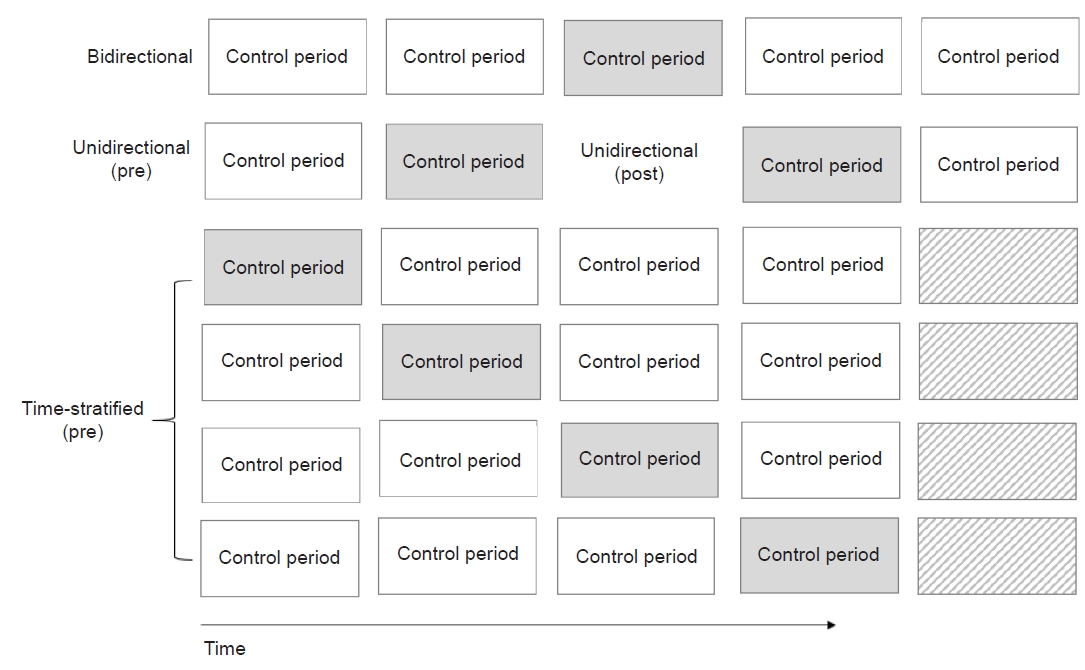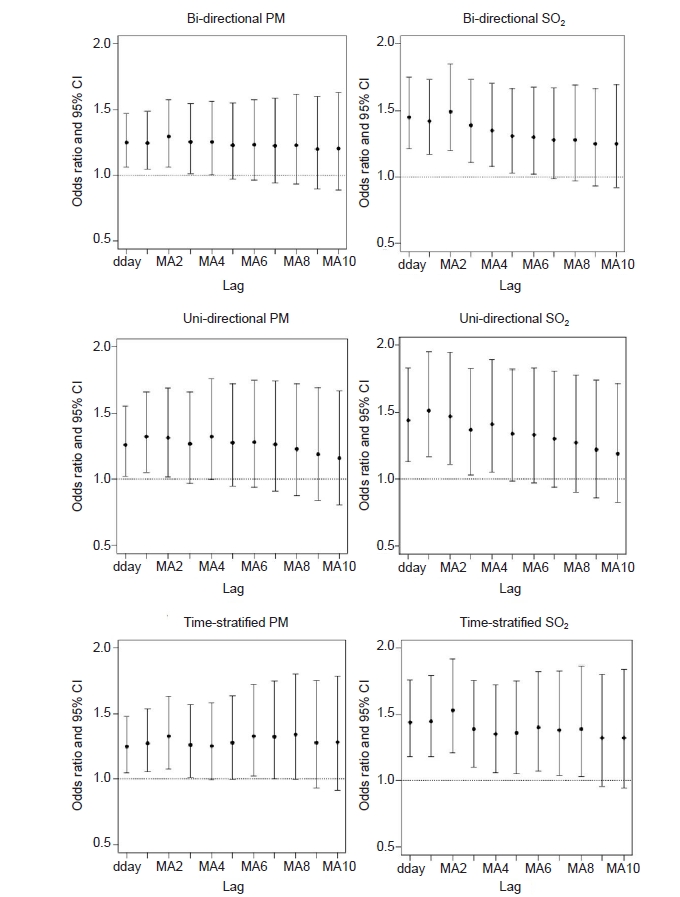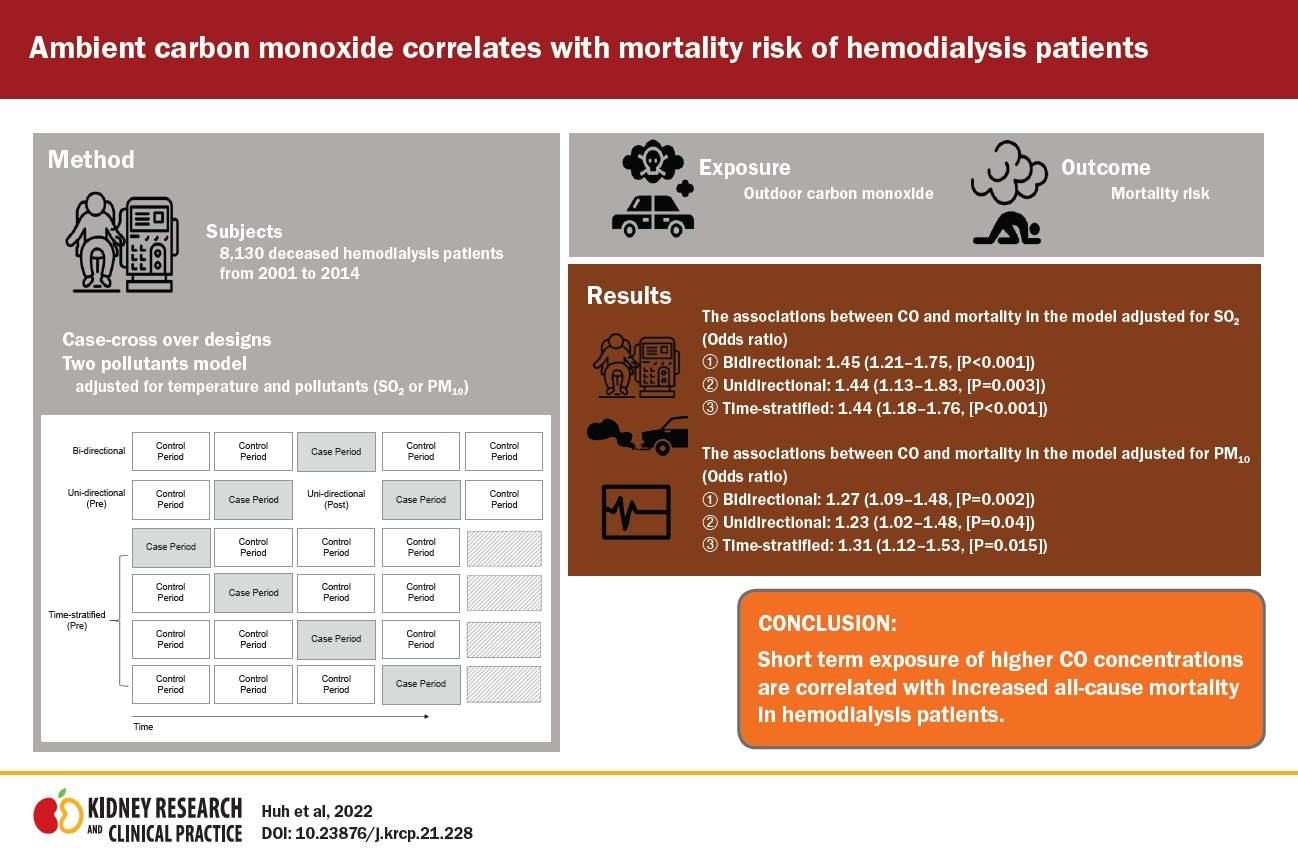1. Cohen AJ, Brauer M, Burnett R, et al. Estimates and 25-year trends of the global burden of disease attributable to ambient air pollution: an analysis of data from the Global Burden of Diseases Study 2015.
Lancet 2017;389:1907ŌĆō1918.



2. Lelieveld J, Evans JS, Fnais M, Giannadaki D, Pozzer A. The contribution of outdoor air pollution sources to premature mortality on a global scale.
Nature 2015;525:367ŌĆō371.


3. Bowe B, Xie Y, Li T, Yan Y, Xian H, Al-Aly Z. Particulate matter air pollution and the risk of incident CKD and progression to ESRD.
J Am Soc Nephrol 2018;29:218ŌĆō230.


4. Bell ML, Peng RD, Dominici F, Samet JM. Emergency hospital admissions for cardiovascular diseases and ambient levels of carbon monoxide: results for 126 United States urban counties, 1999-2005.
Circulation 2009;120:949ŌĆō955.



5. Barnett AG, Williams GM, Schwartz J, et al. The effects of air pollution on hospitalizations for cardiovascular disease in elderly people in Australian and New Zealand cities.
Environ Health Perspect 2006;114:1018ŌĆō1023.



6. Morris RD, Naumova EN, Munasinghe RL. Ambient air pollution and hospitalization for congestive heart failure among elderly people in seven large US cities.
Am J Public Health 1995;85:1361ŌĆō1365.



7. Samoli E, Touloumi G, Schwartz J, et al. Short-term effects of carbon monoxide on mortality: an analysis within the APHEA project.
Environ Health Perspect 2007;115:1578ŌĆō1583.



8. Liu C, Yin P, Chen R, et al. Ambient carbon monoxide and cardiovascular mortality: a nationwide time-series analysis in 272 cities in China.
Lancet Planet Health 2018;2:e12ŌĆōe18.


9. Bowe B, Xie Y, Li T, Yan Y, Xian H, Al-Aly Z. Associations of ambient coarse particulate matter, nitrogen dioxide, and carbon monoxide with the risk of kidney disease: a cohort study.
Lancet Planet Health 2017;1:e267ŌĆōe276.


10. Jin DC. Dialysis registries in the world: Korean Dialysis Registry.
Kidney Int Suppl (2011) 2015;5:8ŌĆō11.



11. Jin DC, Yun SR, Lee SW, Han SW, Kim W, Park J. Current characteristics of dialysis therapy in Korea: 2015 registry data focusing on elderly patients.
Kidney Res Clin Pract 2016;35:204ŌĆō211.



12. Yoon UA, Kim YC, Lee H, et al. The impact of sunlight exposure on mortality of patients with end stage renal disease.
Sci Rep 2019;9:2230.



13. Maclure M. The case-crossover design: a method for studying transient effects on the risk of acute events.
Am J Epidemiol 1991;133:144ŌĆō153.


14. Bateson TF, Schwartz J. Selection bias and confounding in case-crossover analyses of environmental time-series data.
Epidemiology 2001;12:654ŌĆō661.


15. Bateson TF, Schwartz J. Control for seasonal variation and time trend in case-crossover studies of acute effects of environmental exposures.
Epidemiology 1999;10:539ŌĆō544.


16. Guan WJ, Zheng XY, Chung KF, Zhong NS. Impact of air pollution on the burden of chronic respiratory diseases in China: time for urgent action.
Lancet 2016;388:1939ŌĆō1951.


17. Brugha R, Grigg J. Urban air pollution and respiratory infections.
Paediatr Respir Rev 2014;15:194ŌĆō199.


18. Shah AS, Lee KK, McAllister DA, et al. Short term exposure to air pollution and stroke: systematic review and meta-analysis.
BMJ 2015;350:h1295.



19. Chi X, Winderlich J, Mayer JC, et al. Long-term measurements of aerosol and carbon monoxide at the ZOTTO tall tower to characterize polluted and pristine air in the Siberian taiga.
Atmos Chem Phys 2013;13:12271ŌĆō12298.

20. Liu H, Tian Y, Xiang X, et al. Association of short-term exposure to ambient carbon monoxide with hospital admissions in China.
Sci Rep 2018;8:13336.



21. Son JY, Lee JT, Kim H, Yi O, Bell ML. Susceptibility to air pollution effects on mortality in Seoul, Korea: a case-crossover analysis of individual-level effect modifiers.
J Expo Sci Environ Epidemiol 2012;22:227ŌĆō234.



22. Huang WH, Lin JL, Lin-Tan DT, Chen KH, Hsu CW, Yen TH. Impact of living environment on 2-year mortality in elderly maintenance hemodialysis patients.
PLoS One 2013;8:e74358.



23. Allred EN, Bleecker ER, Chaitman BR, et al. Short-term effects of carbon monoxide exposure on the exercise performance of subjects with coronary artery disease.
N Engl J Med 1989;321:1426ŌĆō1432.


24. Kalay N, Ozdogru I, Cetinkaya Y, et al. Cardiovascular effects of carbon monoxide poisoning.
Am J Cardiol 2007;99:322ŌĆō324.


25. Lee FY, Chen WK, Lin CL, Kao CH. Carbon monoxide poisoning and subsequent cardiovascular disease risk: a nationwide population-based cohort study.
Medicine (Baltimore) 2015;94:e624.


26. Prockop LD, Chichkova RI. Carbon monoxide intoxication: an updated review.
J Neurol Sci 2007;262:122ŌĆō130.


27. Weng CH, Hu CC, Yen TH, Huang WH. Association between ambient carbon monoxide and secondary hyperparathyroidism in nondiabetic patients undergoing peritoneal dialysis.
Ther Clin Risk Manag 2015;11:1401ŌĆō1408.


28. Huang WH, Lin JH, Weng CH, Hsu CW, Yen TH. Environmental NO
2 and CO exposure: ignored factors associated with uremic pruritus in patients undergoing hemodialysis.
Sci Rep 2016;6:31168.




29. Croft DP, Zhang W, Lin S, et al. The association between respiratory infection and air pollution in the setting of air quality policy and economic change.
Ann Am Thorac Soc 2019;16:321ŌĆō330.



30. Piantadosi CA. Carbon monoxide, reactive oxygen signaling, and oxidative stress.
Free Radic Biol Med 2008;45:562ŌĆō569.



31. Chin MT. Basic mechanisms for adverse cardiovascular events associated with air pollution.
Heart 2015;101:253ŌĆō256.


32. Tian L, Qiu H, Pun VC, et al. Ambient carbon monoxide associated with reduced risk of hospital admissions for respiratory tract infections.
Am J Respir Crit Care Med 2013;188:1240ŌĆō1245.


33. Tayem Y, Johnson TR, Mann BE, Green CJ, Motterlini R. Protection against cisplatin-induced nephrotoxicity by a carbon monoxide-releasing molecule.
Am J Physiol Renal Physiol 2006;290:F789ŌĆōF794.


34. Wang P, Huang J, Li Y, et al. Exogenous carbon monoxide decreases sepsis-induced acute kidney injury and inhibits NLRP3 inflammasome activation in rats.
Int J Mol Sci 2015;16:20595ŌĆō20608.























 PDF Links
PDF Links PubReader
PubReader ePub Link
ePub Link Full text via DOI
Full text via DOI Download Citation
Download Citation Supplement 1
Supplement 1 Print
Print















